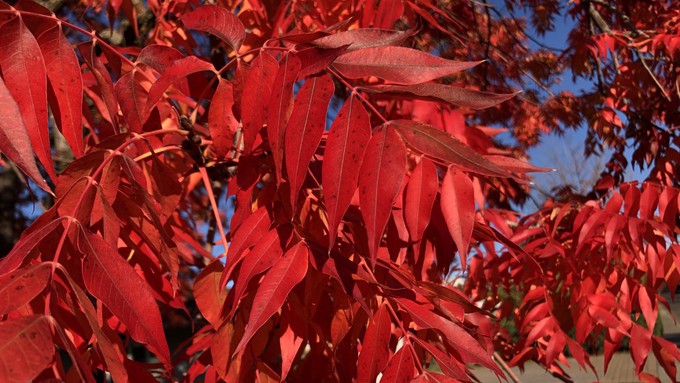
Just in time for fall color, new self-guided tour teaches about varieties on campus

Chinese pistache trees are putting on a show this fall. See many varieties of trees in full color on the walking tour of the UC Davis campus, including the Arboretum and Public Garden. Kathy Morrison
Have you noticed? We’re having a spectacular tree season!
This month, maples, pistaches, ginkgos and other deciduous trees are putting on a colorful show with rich reds, golds and oranges.
Before those leaves are gone, check out the gorgeous trees at the UC Davis Arboretum with the help of a new self-guided tour of campus trees.
“This tour moves you through a 1.5-mile loop on the UC Davis campus while teaching you about both common and unique tree species,” says the arboretum staff. “It’s perfect for navigating in-person from your smartphone!”
You also can check it out on your laptop computer or tablet. Find the links here: https://storymaps.arcgis.com/stories/ed81abebde784d2f824268402fb3ed1b
The tour and virtual resources were created by students participating in the arboretum’s Learning by Leading Tree Stewardship program. Among the thousands of trees on campus, 21 specimens are highlighted on the self-guided tour.
For visitors to the arboretum, parking on campus is free on holidays and weekends.
Besides the tour, the students also came up with several other tree-friendly resources including webpages on the benefits of trees in a suburban environment, the effects of climate change on our trees and forests, and details on a Campus and Community Action Plan with ways students and residents can support their tree canopy.
More details and links: https://arboretum.ucdavis.edu/trees.
-- Debbie Arrington
Comments
0 comments have been posted.Sacramento Digs Gardening to your inbox.
Food in My Back Yard Series
April 1: Don't be fooled by these garden myths
March 25: Fertilizer tips: How to 'feed' your vegetables for healthy growth
March 18: Time to give vegetable seedlings some more space
March 11: Ways to win the fight against weeds
March 4: Potatoes from the garden
Feb. 25: Plant a fruit tree now -- for later
Feb. 18: How to squeeze more food into less space
Feb. 11: When to plant? Consider staggering your transplants
Feb. 4: Starting in seed starting
Sites We Like
Garden Checklist for week of March 30
Your garden doesn’t mind April showers. Get busy now to enjoy those future flowers.
* Get ready to swing into action in the vegetable garden. As nights warm up over 50 degrees, start setting out tomato, pepper and eggplant transplants.
* From seed, plant beans, beets, cantaloupes, carrots, corn, cucumbers, melons, pumpkins, radishes and squash. (Soak beet seeds overnight in water for better germination,)
* Plant onion sets.
* In the flower garden, plant seeds for asters, cosmos, celosia, marigolds, salvia, sunflowers and zinnias.
* Transplant petunias, zinnias, geraniums and other summer bloomers.
* Plant perennials and dahlia tubers for summer bloom.
* Transplant lettuce and cabbage seedlings.
* April is the last chance to plant citrus trees such as dwarf orange, lemon and kumquat. These trees also look good in landscaping and provide fresh fruit in winter.
* Smell orange blossoms? Feed citrus trees with a low dose of balanced fertilizer (such as 10-10-10) during bloom to help set fruit. Keep an eye out for ants.
* Apply slow-release fertilizer to the lawn.